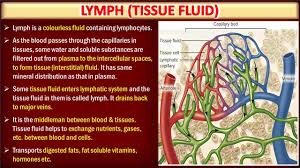Blog
Lymph: Definition, Composition and Function | Free Biology Notes

In this article, we will discuss about Lymph, Composition of Lymph, Formation of Lymph and Functions of lymph
Lymph Definition
Lymph is a clear, colorless fluid that circulates throughout the body. It contains white blood cells and helps to remove waste and toxins from the body, as well as playing a role in the immune system’s response to infection and disease. Lymph is transported through lymphatic vessels and filtered through lymph nodes, which trap and destroy harmful substances such as bacteria and viruses.
Composition of Lymph
The majority of lymph is composed of water, accounting for roughly 95% of its volume. This water is collected from the body’s tissues and serves as a critical carrier for various molecules and cells throughout the lymphatic system. Lymphatic vessels collect the water from the tissues and transport it through the lymphatic system, where it is eventually returned to the bloodstream.
Alongside water, lymph also contains a variety of proteins and other molecules that are essential for maintaining a healthy immune system. One of the most critical of these molecules are white blood cells, which are responsible for fighting off infections and diseases within the body. Lymph is rich in these cells, which are transported throughout the lymphatic system to help identify and destroy harmful pathogens.
Additionally, lymph contains a variety of other substances, including lipids and hormones. Lipids, in particular, play an essential role in the body’s absorption of fat-soluble nutrients, such as vitamins A, D, E, and K. Lymphatic vessels within the small intestine absorb these lipids and transport them through the lymphatic system, where they eventually enter the bloodstream and provide essential nutrients to the body.
How Lymph is Formed From Blood
- As the blood passes through the capillaries in tissues, some water and soluble substances are filtered out from plasma to the intercellular spaces, to form tissue (interstitial) fluid. It has same mineral distribution as that in plasma.
- Some tissue fluid enters lymphatic system and the tissue fluid in them is called lymph. It drains back to major veins.
- It is the middleman between blood & tissues. Tissue fluid helps to exchange nutrients, gases, etc. between blood and cells.
- Transports digested fats, fat soluble vitamins, hormones etc.
Functions of lymph
Immune System: The lymphatic system plays a critical role in the body’s immune response. Lymph contains white blood cells, including lymphocytes and macrophages, which are responsible for identifying and destroying harmful pathogens such as bacteria, viruses, and cancer cells. Lymph nodes, which are located throughout the body, act as filters, trapping and destroying these pathogens before they can cause harm to the body.
Fluid Balance: The lymphatic system is also responsible for maintaining fluid balance within the body. As blood circulates through the body’s capillaries, fluid and other molecules are forced out of the blood vessels and into the surrounding tissues. The lymphatic system collects this excess fluid, along with waste products and toxins, and returns them to the bloodstream. This helps to prevent the buildup of excess fluid and maintain proper fluid balance within the body.
Fat Absorption: In addition to its role in immune function and fluid balance, lymph also plays a critical role in the absorption of fats and fat-soluble nutrients. Lymphatic vessels within the small intestine absorb dietary fats, which are then transported through the lymphatic system to the bloodstream. This process is essential for the absorption of fat-soluble vitamins, such as vitamins A, D, E, and K, which are critical for proper body function.
Wound Healing: Lymph also plays an essential role in wound healing. As the body responds to injury or infection, lymphatic vessels in the affected area dilate, allowing immune cells and other important molecules to enter the site of injury. This helps to promote healing and prevent the spread of infection throughout the body.

 Entertainment1 month ago
Entertainment1 month agoIbomma Bappam: Redefines Telugu Streaming Trend

 Blog1 month ago
Blog1 month ago[PPT] The living world Class 11 Notes

 Blog1 month ago
Blog1 month ago[PPT] Human Reproduction Class 12 Notes
- Blog1 month ago
PG TRB Botany Study Material PDF Free Download
- Blog1 month ago
Class 12 Biology Notes Chapter wise PPT

 Blog1 month ago
Blog1 month agoIosmirror.cc Apk: Enables Smart Screen Sharing

 Blog1 month ago
Blog1 month agoDownload NEET Biology Study Materials in Tamil
- Blog1 month ago
Class 11 Biology Notes Chapter wise PPT












